Not many types of paper are needed for making cartons manufacturing, but we need to know many things to source the perfect paper for carton boxes. For the carton manufacturing process, its paper is important for maintaining the very good quality of the carton boxes. In this article, we are going to discuss the corrugating paper, different liner paper (which need for making cartons) sourcing techniques, types of papers used to make a carton box and some important factors of sourcing. Hope this article will help any carton box manufacturer who is supplying cartons to garments manufacturers, the fashion industry, and other industries.
What is the sourcing Technique?
A good sourcing technique requires a thorough understanding of a company’s business technique, the resources required to deliver that technique, the market forces, and the unique risks within the company associated with implementing specific approaches. A periodic review of the sourcing technique ensures the achievement of desired results and continued alignment with business objectives. Here some of the sourcing techniques are used nowadays in supply chain management today include:
- Single sourcing: Single sourcing is a supplier for a product, a method whereby a purchased part is supplied by only one supplier. A JIT (Just-in-time) manufacturer will always have only one supplier for a purchased material so that close relationships and good quality can be established with a smaller number of suppliers. A close relationship with a single supplier (and mutual interdependence) fosters high quality, reliability, short lead times, and cooperative action if the supplier is able to deliver.
- Multi sourcing: A method of sourcing where the procurement of materials or services from more than one independent supplier. In this case, companies may use it sometimes to induce healthy competition (Order volume / MOQ should be high) between the suppliers in order to achieve better quality with lower prices.
- Outsourcing: The process of having suppliers provide materials and services that were previously provided internally. Outsourcing involves substitution for the replacement of internal capacity and production by that of the supplier.
- Insourcing: The materials or services are developed internally, no need for any supplier for sourcing.
Why sourcing technique is needed for paper?
We live by oxygen whereas oxygen comes from trees. The papers are used to make various packaging accessories that come from these trees. Besides, the raw material of this paper is the pulp which is made from the skin of the tree and which is expensive also. Around the world, few countries supply pulp and have their own forest. But others are dependent on them and that is why they have to buy the pulp at a higher price. The technique has to make for mitigating the risks and to source the paper easily around the world.
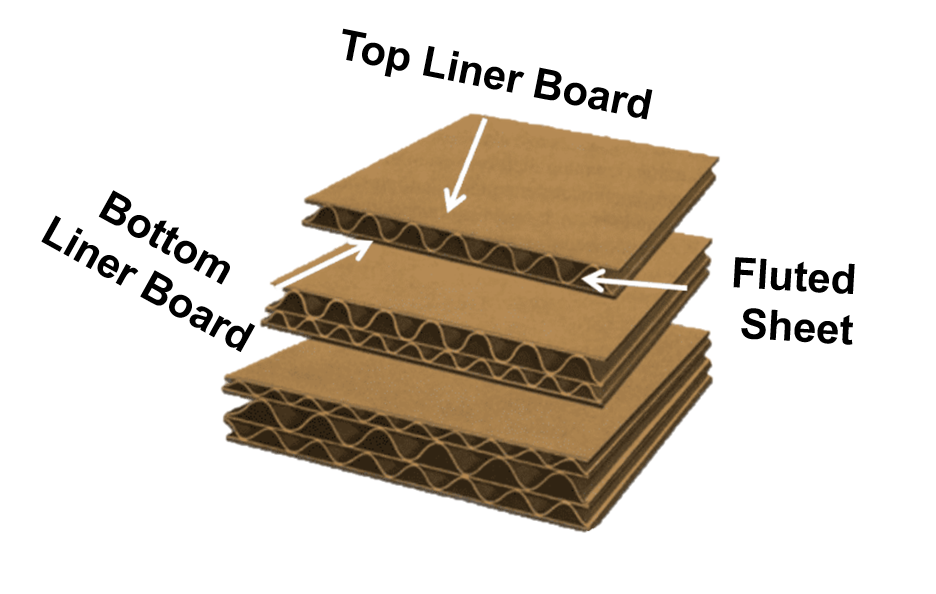
Corrugated paper
A corrugated paper sheet is a material consisting of a fluted paper sheet and one or two plain liner boards. It is made on corrugators and is used in the manufacture of corrugated boxes for normal packaging. It is the main paper used in a corrugated carton box, that is why called a corrugated carton.
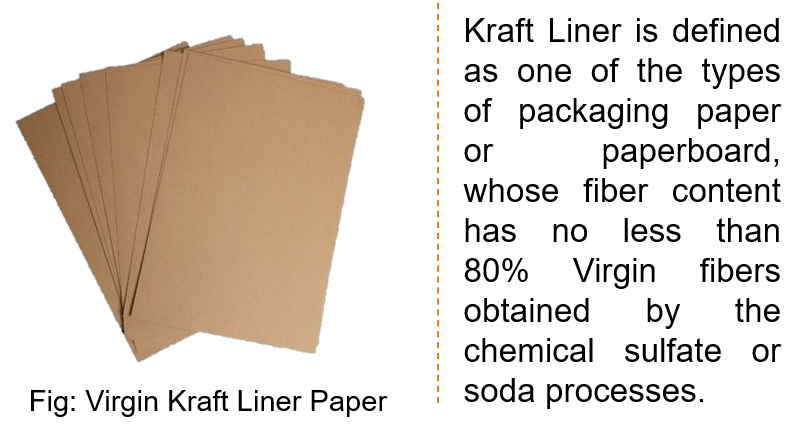
Virgin Kraft Liner Paper
Kraft Liner is defined as one of the types of packaging paper or paperboard, whose fiber content has no less than 80% Virgin fibers obtained by the chemical sulfate or soda processes.
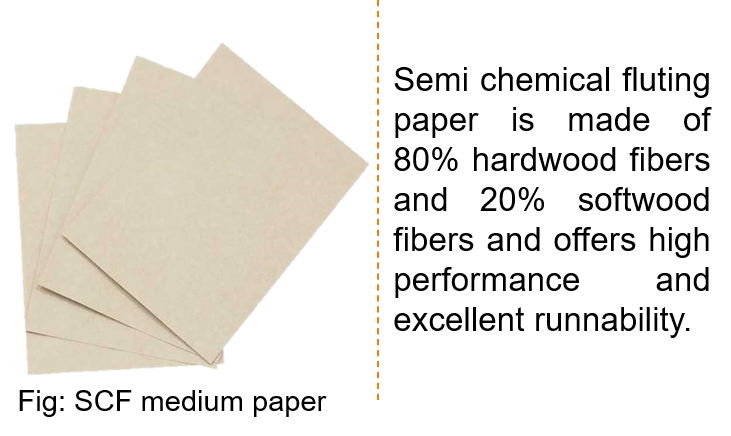
Semi chemical fluting paper (SCF Paper)
Semi chemical fluting paper is made of 80% hardwood fibers and 20% softwood fibers and offers high performance and excellent runability.
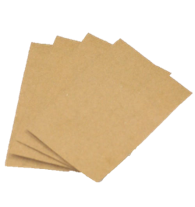
Fluting Medium paper
Fluting paper is the middle liner paper in between two corrugated boards. It provides protection by filling empty spaces in the outer case and providing a cushioning effect for the primary product. it is 100% recyclable and made from a renewable resource.
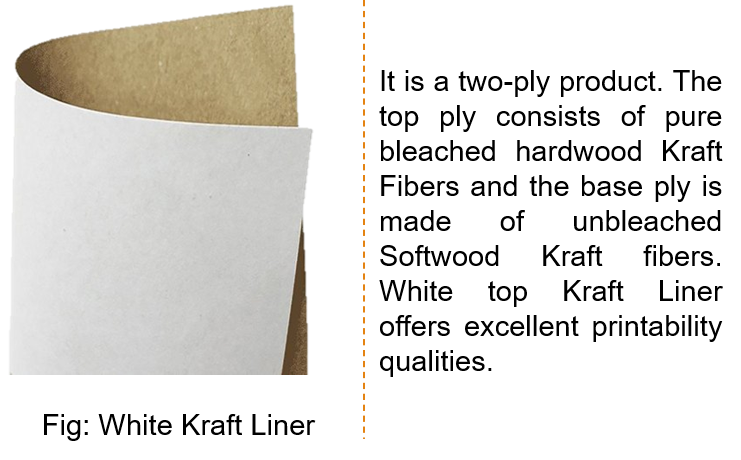
White Kraft Liner
It is a two-ply product. The top ply consists of pure bleached hardwood Kraft Fibers and the base ply is made of unbleached Softwood Kraft fibers. Whitetop Kraft Liner offers excellent printability qualities.
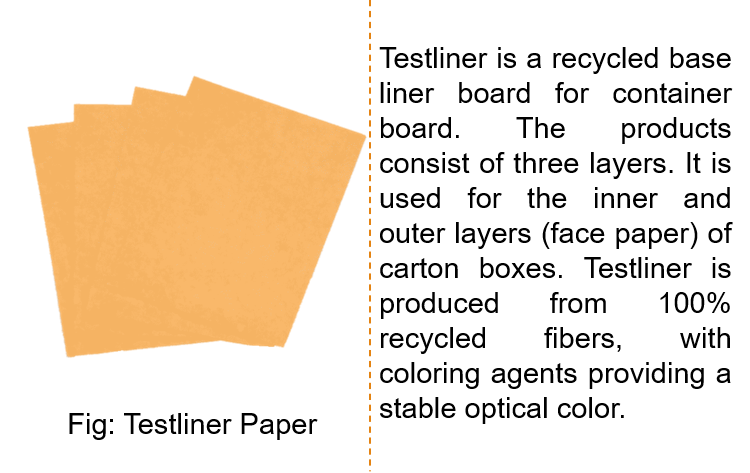
Testliner Paper
Testliner is a recycled baseliner board for containerboard. The products consist of three layers. It is used for the inner and outer layers (face paper) of carton boxes. Testliner is produced from 100% recycled fibers, with coloring agents providing a stable optical color.
Fluting Medium paper
Fluting paper is the middle liner paper between two corrugated boards. It provides protection by filling empty spaces in the outer case and providing a cushioning effect for the primary product. it is 100% recyclable and made from a renewable resource.
Types of the corrugated sheet by the number of ply
Auto Carton: Under the auto carton switch box unit (SBU) two types of corrugated sheets are normally made. They are:
- 3 Ply: Consist of two top liner boards & one fluted sheet
- 5 Ply: Consist of three top liner boards & two fluted sheets
Semi-Auto Carton: Under semi-auto carton, SBU four types of corrugated sheets are normally made. They are:
- 3 Ply: Consist of two top liner boards & one fluted sheet
- 5 Ply: Consist of three top liner boards & two fluted sheets
- 7 Ply: Consist of four top liner boards & three fluted sheets
- 9 Ply: Consist of five top liner boards & four fluted sheets
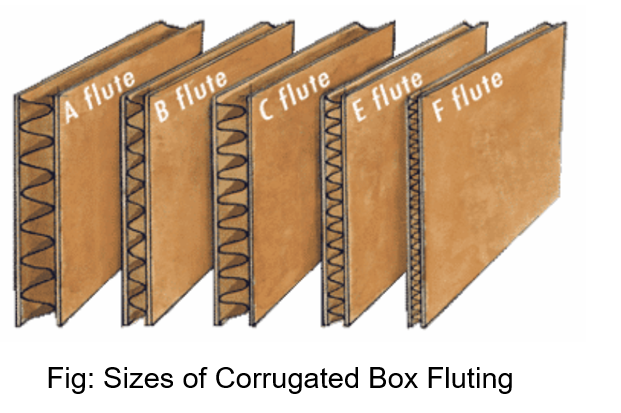
Types of Corrugated sheets by flute design
Depending on customer requirements the flute design is chosen. Based on the flute design the sheet strength varies. Generally, the larger the flute (A & B profiles) the greater the strength and cushioning. And the smaller the flute (D & E profiles) the better the printability and foldability.
A-Flute – This is the original fluting (A-Flute) for corrugated boxes used in cartons. With approximately 36 flutes per foot, it can be used for a double-wall application or a thick corrugated pad.
B-Flute – Primarily used for canned goods packaging (B-Flute), the B flute provides the second-highest arch size at approximately 49 flutes per foot.
C-Flute –This is the most commonly used corrugated box flute. As an all-purpose flute, the C flute has approximately 41 flutes per foot.
E-Flute –The E flute is the second most used corrugated box. At about 90 flutes per foot, it is also used to print high-quality direct print graphics, in comparison to its counterparts.
F-Flute –This small, tighter flute is an environmentally friendly replacement for folding cartons. At approximately 128 flutes per foot, the F flute offers an exceptionally high-value look and provides packaging with solid structural integrity.
Paper Sourcing factors
The sourcing Technique for the paper will depend upon three key factors according to the following:
- Quality
- Delivery Lead Time
- Price
Quality:
In the case of sourcing from suppliers’, primacy will be the quality of goods. For corrugated papers, there are a number of quality parameters like BST, RCT, Cobb & Moisture % value. The supplier’s paper must meet this quality according to our set standards. Even after offering a lower price & lead time, suppliers will not get the order if they fail to fulfill the quality requirements as Quality should be the 1st priority.
Delivery Lead Time:
The 2nd priority will be a delivery lead time. If a supplier offers a lower price but the ‘LC open to goods inhouse’ time from them is higher for starting the production at the right time, then we will not source from them. In this case, a supplier who can provide a lower lead time will get the order even if their price is higher than the above-mentioned supplier.
Price:
If a supplier can meet both qualities & desired lead time, then negotiation will be done based on price. A comparative statement will be made including these suppliers. Then the party who offers the lowest price will get the order.
- References: https://scm.ncsu.edu/scm-articles/article/sourcing-technique/
- https://www.paperindex.com/product-details/fluting-paper/71828/
- https://amsgroupbd.com/projects/kraft-liner/
- https://pgpaper.com/types-of-packaging-paper/
- https://hughesent.com/corrugated-box-flute-types/

Hi, this is my first time visiting this web page. This blog is really informative for me. Thanks for sharing. keep posting. This Blog Is really informative for us. Thanks For sharing this blog.